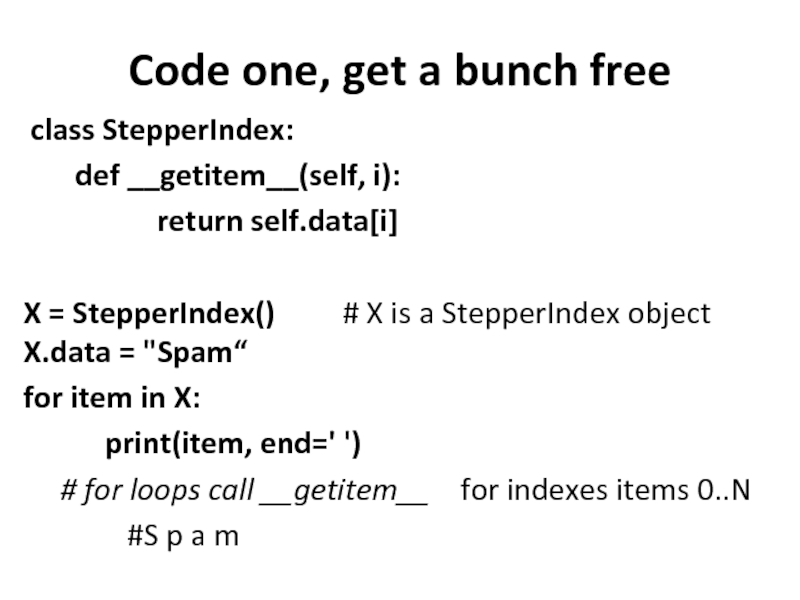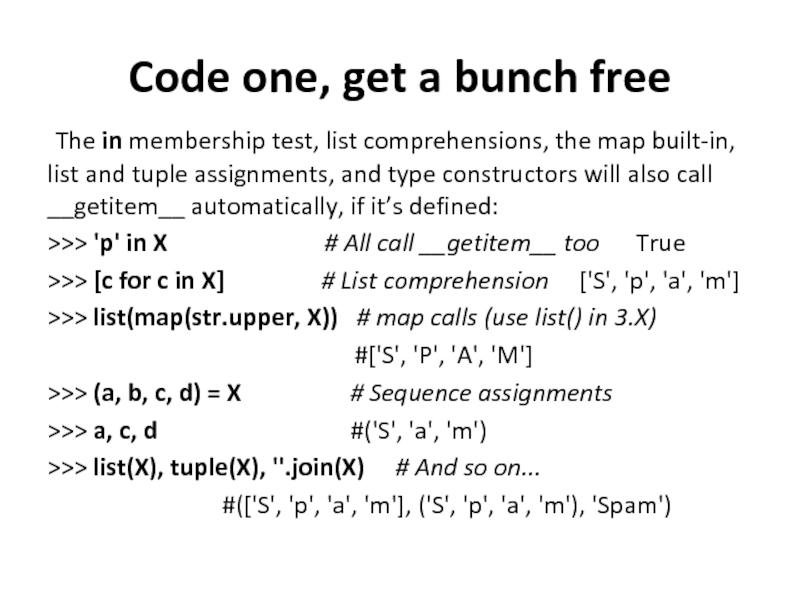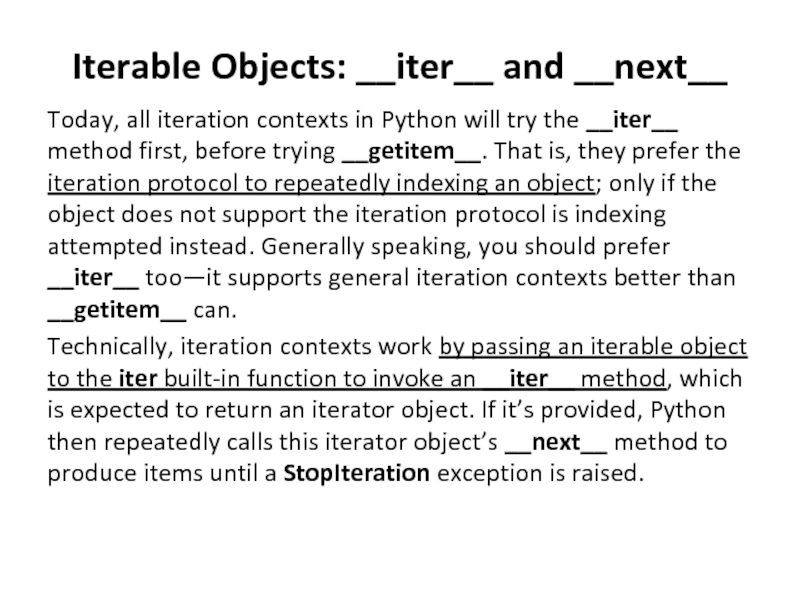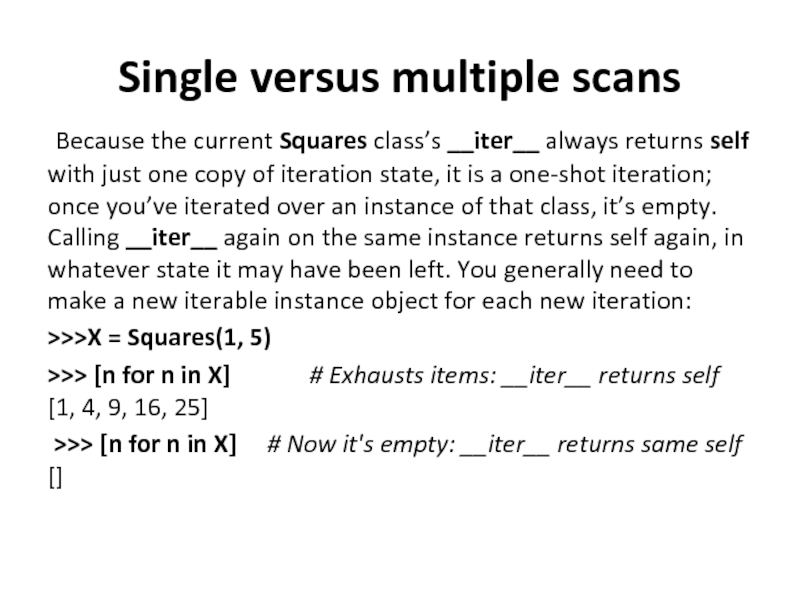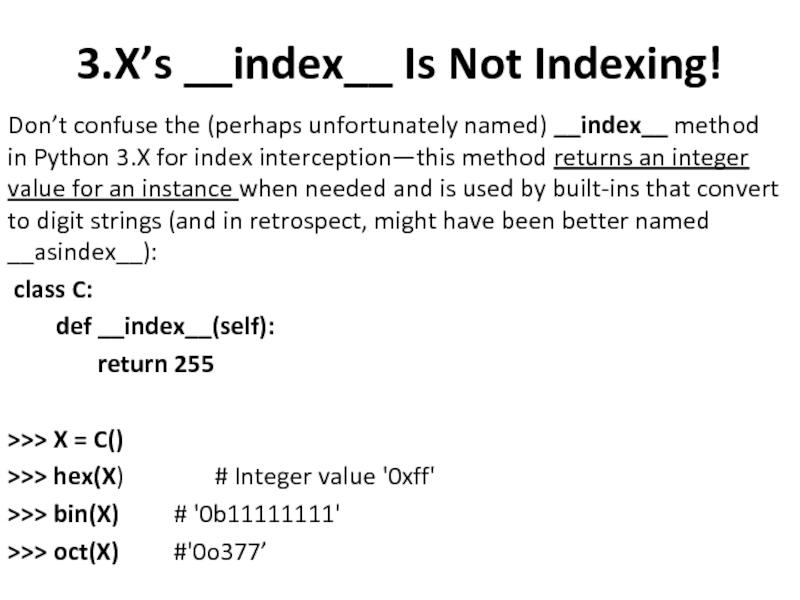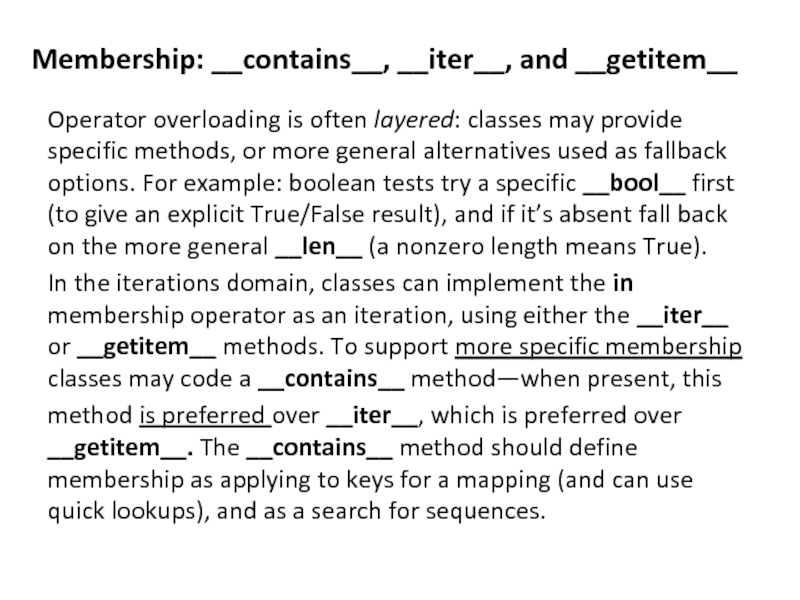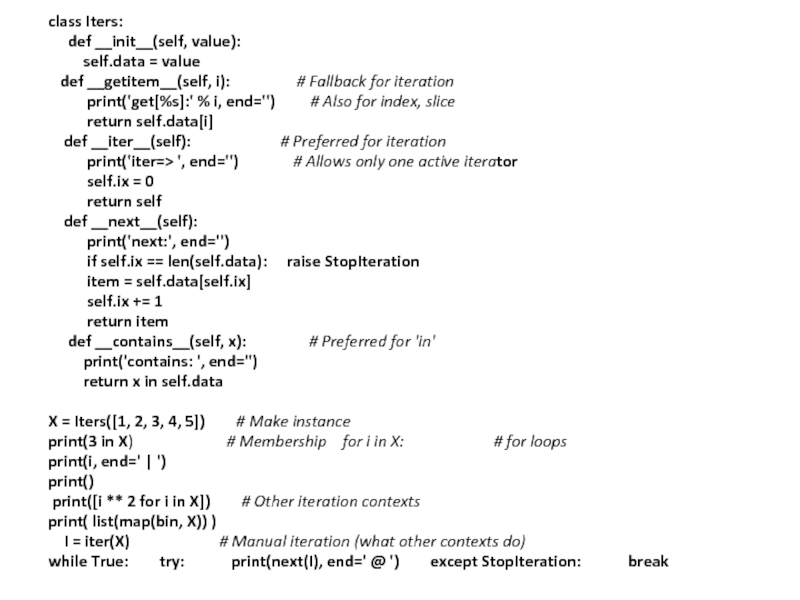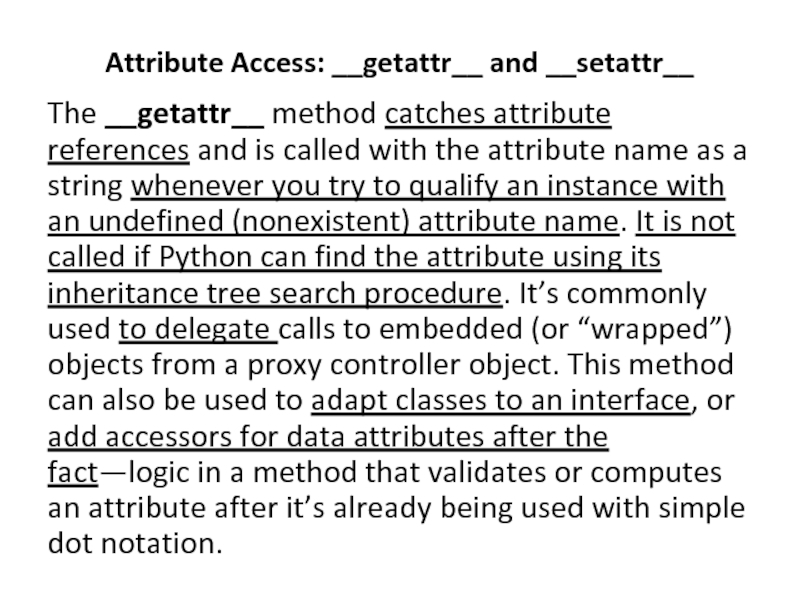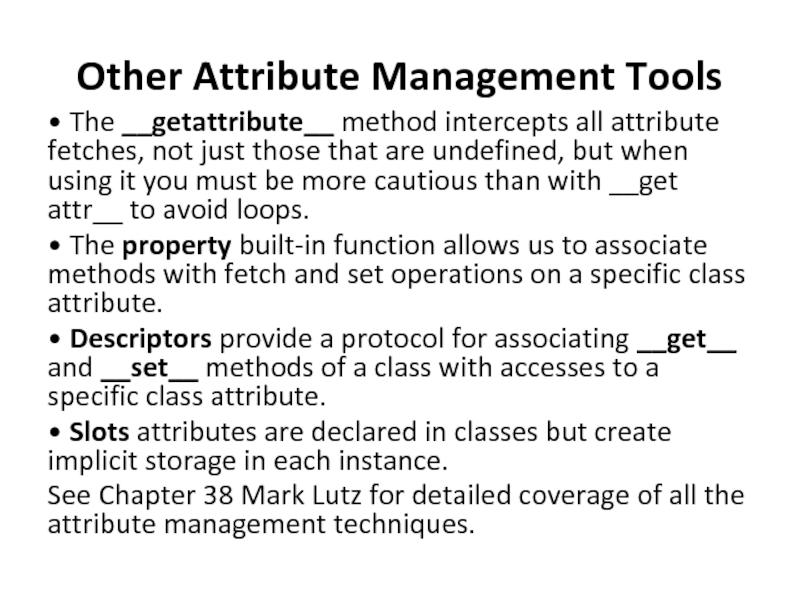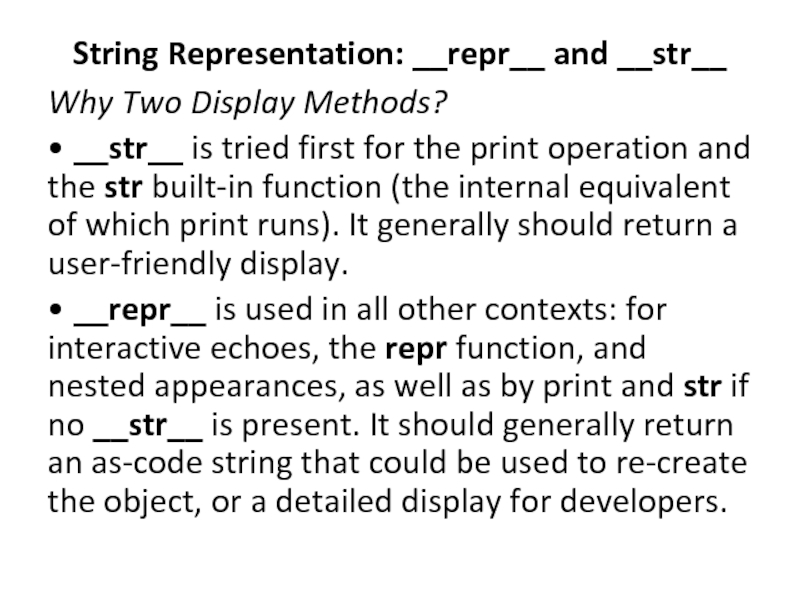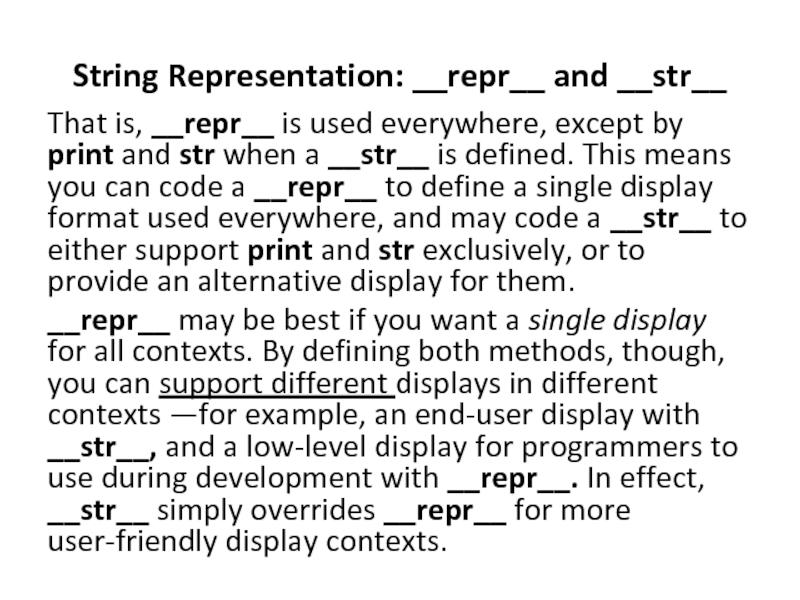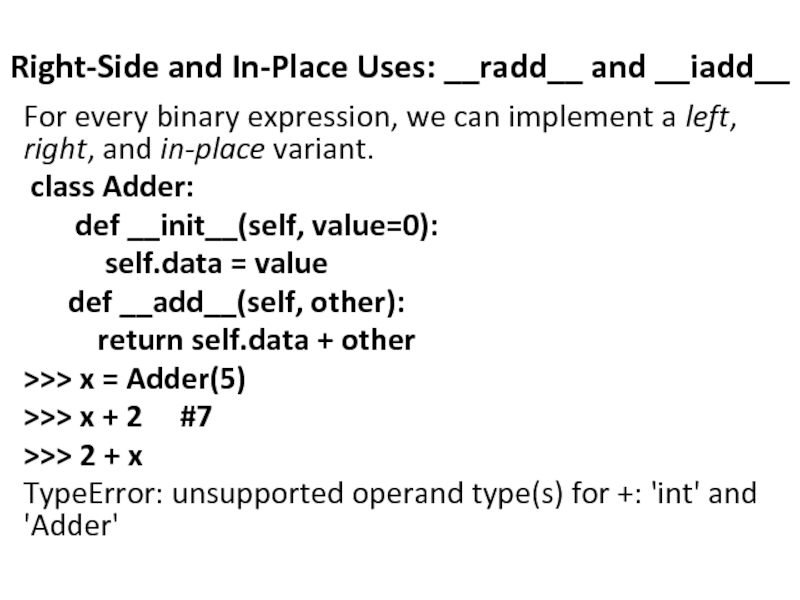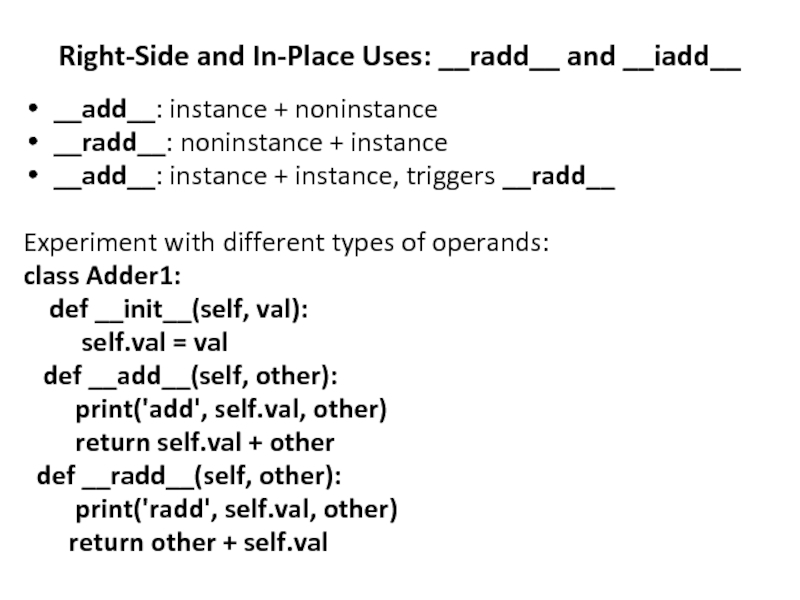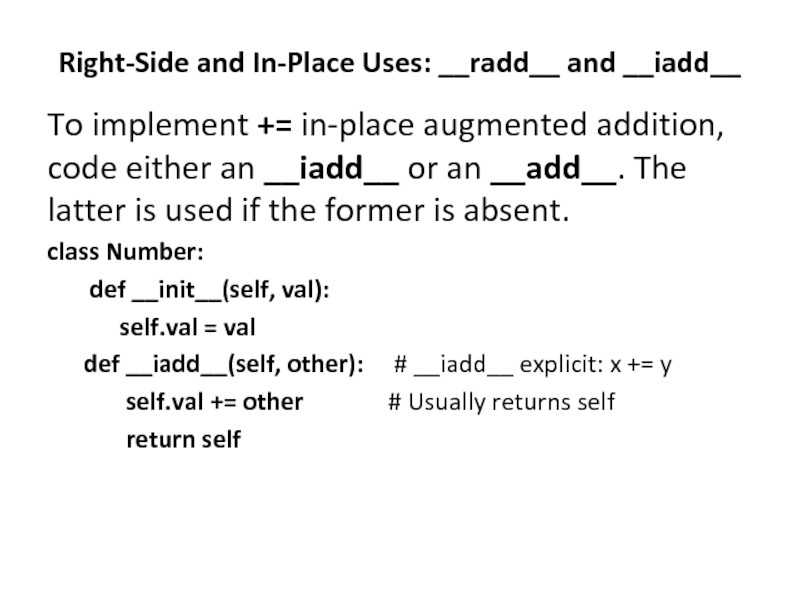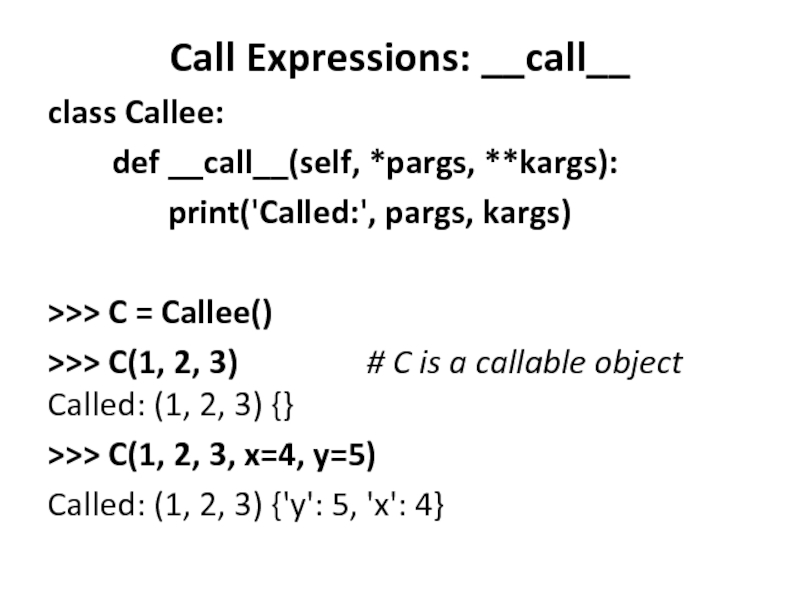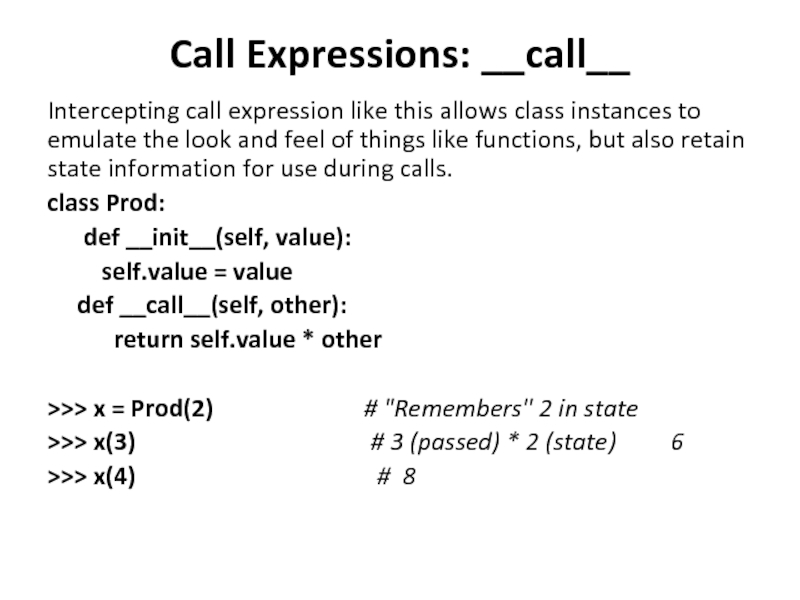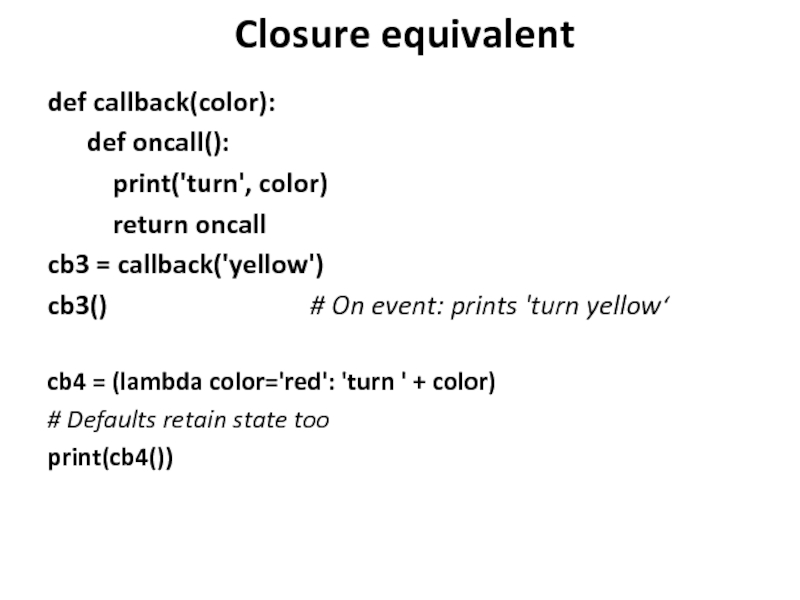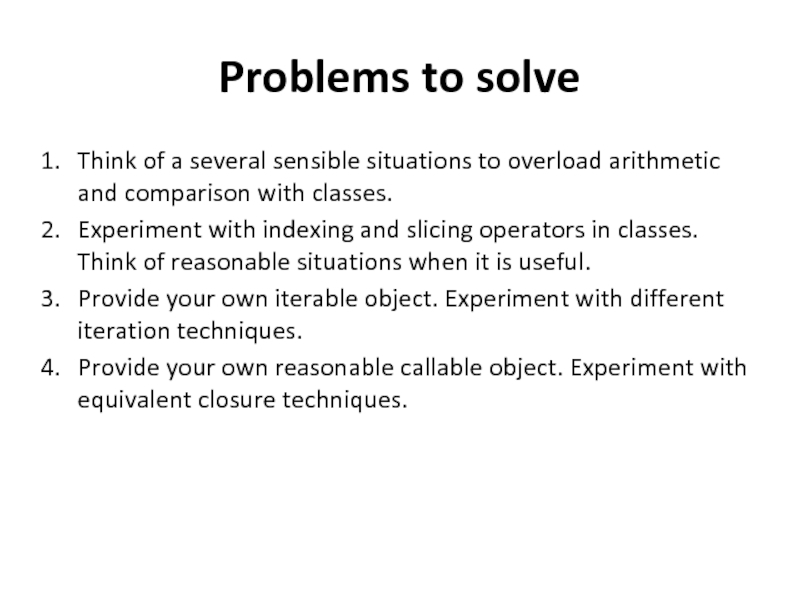- Главная
- Разное
- Дизайн
- Бизнес и предпринимательство
- Аналитика
- Образование
- Развлечения
- Красота и здоровье
- Финансы
- Государство
- Путешествия
- Спорт
- Недвижимость
- Армия
- Графика
- Культурология
- Еда и кулинария
- Лингвистика
- Английский язык
- Астрономия
- Алгебра
- Биология
- География
- Детские презентации
- Информатика
- История
- Литература
- Маркетинг
- Математика
- Медицина
- Менеджмент
- Музыка
- МХК
- Немецкий язык
- ОБЖ
- Обществознание
- Окружающий мир
- Педагогика
- Русский язык
- Технология
- Физика
- Философия
- Химия
- Шаблоны, картинки для презентаций
- Экология
- Экономика
- Юриспруденция
Operator overloading презентация
Содержание
- 1. Operator overloading
- 2. General concepts • Operator overloading lets classes
- 3. Simple example class Number:
- 4. Common operator overloading methods __init__
- 5. Common operator overloading methods __len__
- 6. Indexing and Slicing: __getitem__ and __setitem__
- 7. Indexing and Slicing: __getitem__ and __setitem__
- 8. Indexing and Slicing: __getitem__ and __setitem__
- 9. Code one, get a bunch free
- 10. Code one, get a bunch free
- 11. Iterable Objects: __iter__ and __next__ Today,
- 12. User-Defined Iterables class Squares:
- 13. Single versus multiple scans Because
- 14. 3.X’s __index__ Is Not Indexing! Don’t confuse
- 15. Membership: __contains__, __iter__, and __getitem__ Operator
- 16. class Iters:
- 17. Attribute Access: __getattr__ and __setattr__ The
- 18. Attribute Access: __getattr__ and __setattr__ class
- 19. Attribute Access: __getattr__ and __setattr__
- 20. Other Attribute Management Tools • The
- 21. String Representation: __repr__ and __str__ Why
- 22. String Representation: __repr__ and __str__ That
- 23. Compare
- 24. Right-Side and In-Place Uses: __radd__ and __iadd__
- 25. Right-Side and In-Place Uses: __radd__ and __iadd__
- 26. Right-Side and In-Place Uses: __radd__ and __iadd__
- 27. Call Expressions: __call__ class Callee:
- 28. Call Expressions: __call__ Intercepting call expression
- 29. Call Expressions: __call__ More useful example:
- 30. Closure equivalent def callback(color):
- 31. Problems to solve Think of a several
Слайд 2General concepts
• Operator overloading lets classes intercept normal Python operations.
•
Classes can overload all Python expression operators.
• Classes can also overload built-in operations such as printing, function calls, attribute access, etc.
• Overloading makes class instances act more like built-in types.
• Overloading is implemented by providing specially named methods in a class.
• Classes can also overload built-in operations such as printing, function calls, attribute access, etc.
• Overloading makes class instances act more like built-in types.
• Overloading is implemented by providing specially named methods in a class.
Слайд 3Simple example
class Number:
def __init__(self, start):
self.data = start
def __sub__(self, other):
return Number(self.data - other)
>>> from number import Number
>>> X = Number(5) # Number.__init__(X, 5)
>>> Y = X - 2 # Number.__sub__(X, 2)
>>> Y.data # Y is new Number instance
3
Слайд 4Common operator overloading methods
__init__ Constructor
Object creation: X = Class(args)
__del__ Destructor Object reclamation of X
__add__ Operator + X + Y, X += Y if no __iadd__
__or__ Operator | (bitwise OR) X | Y, X |= Y if no __ior__
__repr__, __str__ Printing, conversions print(X), repr(X), str(X)
__call__ Function calls X(*args, **kargs)
__getattr__ Attribute fetch X.undefined
__setattr__ Attribute assignment X.any = value
__delattr__ Attribute deletion del X.any
__getattribute__ Attribute fetch X.any
__getitem__ Indexing, slicing, iteration X[key], X[i:j], for loops and other iterations if no __iter__
__setitem__ Index and slice assignment X[key] = value, X[i:j] = iterable __delitem__ Index and slice deletion del X[key], del X[i:j]
__del__ Destructor Object reclamation of X
__add__ Operator + X + Y, X += Y if no __iadd__
__or__ Operator | (bitwise OR) X | Y, X |= Y if no __ior__
__repr__, __str__ Printing, conversions print(X), repr(X), str(X)
__call__ Function calls X(*args, **kargs)
__getattr__ Attribute fetch X.undefined
__setattr__ Attribute assignment X.any = value
__delattr__ Attribute deletion del X.any
__getattribute__ Attribute fetch X.any
__getitem__ Indexing, slicing, iteration X[key], X[i:j], for loops and other iterations if no __iter__
__setitem__ Index and slice assignment X[key] = value, X[i:j] = iterable __delitem__ Index and slice deletion del X[key], del X[i:j]
Слайд 5Common operator overloading methods
__len__ Length
len(X), truth tests if no __bool__ __bool__ Boolean tests bool(X), truth tests
__lt__, __gt__, __le__, __ge__, __eq__, __ne__
Comparisons X < Y, X > Y, X <= Y, X >= Y, X == Y, X != Y
__radd__ Right-side operators Other + X
__iadd__ In-place augmented operators X += Y (or else __add__)
__iter__, __next__ Iteration contexts I=iter(X), next(I); for loops, in if no __contains__, all comprehensions, map(F,X), others
__contains__ Membership test item in X (any iterable)
__index__ Integer value hex(X), bin(X), oct(X), O[X], O[X:]
__enter__, __exit__ Context manager (Chapter 34) with obj as var:
__get__, __set__,
__delete__ Descriptor attributes (Chapter 38) X.attr, X.attr = value, del X.attr
__new__ Creation (Chapter 40) Object creation, before __init__
__lt__, __gt__, __le__, __ge__, __eq__, __ne__
Comparisons X < Y, X > Y, X <= Y, X >= Y, X == Y, X != Y
__radd__ Right-side operators Other + X
__iadd__ In-place augmented operators X += Y (or else __add__)
__iter__, __next__ Iteration contexts I=iter(X), next(I); for loops, in if no __contains__, all comprehensions, map(F,X), others
__contains__ Membership test item in X (any iterable)
__index__ Integer value hex(X), bin(X), oct(X), O[X], O[X:]
__enter__, __exit__ Context manager (Chapter 34) with obj as var:
__get__, __set__,
__delete__ Descriptor attributes (Chapter 38) X.attr, X.attr = value, del X.attr
__new__ Creation (Chapter 40) Object creation, before __init__
Слайд 6Indexing and Slicing: __getitem__ and __setitem__
class Indexer:
def __getitem__(self, index):
return index ** 2
>>> X = Indexer() >>> X[2] # X[i] calls X.__getitem__(i)
4
>>> for i in range(5):
print(X[i], end=' ') # Runs __getitem__(X, i) each time
0 1 4 9 16
Слайд 7Indexing and Slicing: __getitem__ and __setitem__
>>> class Indexer:
data = [5, 6, 7, 8, 9]
def __getitem__(self, index): # Called for index or slice
print('getitem:', index)
return self.data[index] # Perform index or slice
>>> X = Indexer()
>>> X[0] # Indexing sends __getitem__ an integer getitem: 0 #5
>>> X[1]
getitem: 1 #6
>>> X[-1]
getitem: −1 #9
Слайд 8Indexing and Slicing: __getitem__ and __setitem__
>>> X[2:4]
# Slicing sends __getitem__ a slice object
getitem: slice(2, 4, None) #[7, 8]
>>> X[1:]
getitem: slice(1, None, None) #[6, 7, 8, 9]
>>> X[:-1]
getitem: slice(None, −1, None) #[5, 6, 7, 8]
>>> X[::2]
getitem: slice(None, None, 2) #[5, 7, 9]
class IndexSetter:
def __setitem__(self, index, value): # Intercept index or slice assignment
...
self.data[index] = value # Assign index or slice
getitem: slice(2, 4, None) #[7, 8]
>>> X[1:]
getitem: slice(1, None, None) #[6, 7, 8, 9]
>>> X[:-1]
getitem: slice(None, −1, None) #[5, 6, 7, 8]
>>> X[::2]
getitem: slice(None, None, 2) #[5, 7, 9]
class IndexSetter:
def __setitem__(self, index, value): # Intercept index or slice assignment
...
self.data[index] = value # Assign index or slice
Слайд 9Code one, get a bunch free
class StepperIndex:
def __getitem__(self, i):
return self.data[i]
X = StepperIndex() # X is a StepperIndex object X.data = "Spam“
for item in X:
print(item, end=' ')
# for loops call __getitem__ for indexes items 0..N
#S p a m
Слайд 10Code one, get a bunch free
The in membership test, list
comprehensions, the map built-in, list and tuple assignments, and type constructors will also call __getitem__ automatically, if it’s defined:
>>> 'p' in X # All call __getitem__ too True
>>> [c for c in X] # List comprehension ['S', 'p', 'a', 'm']
>>> list(map(str.upper, X)) # map calls (use list() in 3.X)
#['S', 'P', 'A', 'M']
>>> (a, b, c, d) = X # Sequence assignments
>>> a, c, d #('S', 'a', 'm')
>>> list(X), tuple(X), ''.join(X) # And so on...
#(['S', 'p', 'a', 'm'], ('S', 'p', 'a', 'm'), 'Spam')
>>> 'p' in X # All call __getitem__ too True
>>> [c for c in X] # List comprehension ['S', 'p', 'a', 'm']
>>> list(map(str.upper, X)) # map calls (use list() in 3.X)
#['S', 'P', 'A', 'M']
>>> (a, b, c, d) = X # Sequence assignments
>>> a, c, d #('S', 'a', 'm')
>>> list(X), tuple(X), ''.join(X) # And so on...
#(['S', 'p', 'a', 'm'], ('S', 'p', 'a', 'm'), 'Spam')
Слайд 11Iterable Objects: __iter__ and __next__
Today, all iteration contexts in Python
will try the __iter__ method first, before trying __getitem__. That is, they prefer the iteration protocol to repeatedly indexing an object; only if the object does not support the iteration protocol is indexing attempted instead. Generally speaking, you should prefer __iter__ too—it supports general iteration contexts better than __getitem__ can.
Technically, iteration contexts work by passing an iterable object to the iter built-in function to invoke an __iter__ method, which is expected to return an iterator object. If it’s provided, Python then repeatedly calls this iterator object’s __next__ method to produce items until a StopIteration exception is raised.
Technically, iteration contexts work by passing an iterable object to the iter built-in function to invoke an __iter__ method, which is expected to return an iterator object. If it’s provided, Python then repeatedly calls this iterator object’s __next__ method to produce items until a StopIteration exception is raised.
Слайд 12User-Defined Iterables
class Squares:
def __init__(self, start,
stop):
self.value = start - 1
self.stop = stop
def __iter__(self): # Get iterator object on iter
return self
def __next__(self): # Return a square on each iteration
if self.value == self.stop: # Also called by next built-in
raise StopIteration
self.value += 1
return self.value ** 2
for i in Squares(1, 5): # for calls iter, which calls __iter__
print(i, end=' ') # Each iteration calls __next__
1 4 9 16 25
self.value = start - 1
self.stop = stop
def __iter__(self): # Get iterator object on iter
return self
def __next__(self): # Return a square on each iteration
if self.value == self.stop: # Also called by next built-in
raise StopIteration
self.value += 1
return self.value ** 2
for i in Squares(1, 5): # for calls iter, which calls __iter__
print(i, end=' ') # Each iteration calls __next__
1 4 9 16 25
Слайд 13Single versus multiple scans
Because the current Squares class’s __iter__
always returns self with just one copy of iteration state, it is a one-shot iteration; once you’ve iterated over an instance of that class, it’s empty. Calling __iter__ again on the same instance returns self again, in whatever state it may have been left. You generally need to make a new iterable instance object for each new iteration:
>>>X = Squares(1, 5)
>>> [n for n in X] # Exhausts items: __iter__ returns self [1, 4, 9, 16, 25]
>>> [n for n in X] # Now it's empty: __iter__ returns same self []
>>>X = Squares(1, 5)
>>> [n for n in X] # Exhausts items: __iter__ returns self [1, 4, 9, 16, 25]
>>> [n for n in X] # Now it's empty: __iter__ returns same self []
Слайд 143.X’s __index__ Is Not Indexing!
Don’t confuse the (perhaps unfortunately named) __index__
method in Python 3.X for index interception—this method returns an integer value for an instance when needed and is used by built-ins that convert to digit strings (and in retrospect, might have been better named __asindex__):
class C:
def __index__(self):
return 255
>>> X = C()
>>> hex(X) # Integer value '0xff'
>>> bin(X) # '0b11111111'
>>> oct(X) #'0o377’
class C:
def __index__(self):
return 255
>>> X = C()
>>> hex(X) # Integer value '0xff'
>>> bin(X) # '0b11111111'
>>> oct(X) #'0o377’
Слайд 15Membership: __contains__, __iter__, and __getitem__
Operator overloading is often layered: classes
may provide specific methods, or more general alternatives used as fallback options. For example: boolean tests try a specific __bool__ first (to give an explicit True/False result), and if it’s absent fall back on the more general __len__ (a nonzero length means True).
In the iterations domain, classes can implement the in membership operator as an iteration, using either the __iter__ or __getitem__ methods. To support more specific membership classes may code a __contains__ method—when present, this
method is preferred over __iter__, which is preferred over __getitem__. The __contains__ method should define membership as applying to keys for a mapping (and can use quick lookups), and as a search for sequences.
In the iterations domain, classes can implement the in membership operator as an iteration, using either the __iter__ or __getitem__ methods. To support more specific membership classes may code a __contains__ method—when present, this
method is preferred over __iter__, which is preferred over __getitem__. The __contains__ method should define membership as applying to keys for a mapping (and can use quick lookups), and as a search for sequences.
Слайд 16
class Iters:
def __init__(self, value):
self.data = value
def __getitem__(self, i): # Fallback for iteration
print('get[%s]:' % i, end='') # Also for index, slice
return self.data[i]
def __iter__(self): # Preferred for iteration
print('iter=> ', end='') # Allows only one active iterator
self.ix = 0
return self
def __next__(self):
print('next:', end='')
if self.ix == len(self.data): raise StopIteration
item = self.data[self.ix]
self.ix += 1
return item
def __contains__(self, x): # Preferred for 'in'
print('contains: ', end='')
return x in self.data
X = Iters([1, 2, 3, 4, 5]) # Make instance
print(3 in X) # Membership for i in X: # for loops
print(i, end=' | ')
print()
print([i ** 2 for i in X]) # Other iteration contexts
print( list(map(bin, X)) )
I = iter(X) # Manual iteration (what other contexts do)
while True: try: print(next(I), end=' @ ') except StopIteration: break
Слайд 17Attribute Access: __getattr__ and __setattr__
The __getattr__ method catches attribute references
and is called with the attribute name as a string whenever you try to qualify an instance with an undefined (nonexistent) attribute name. It is not called if Python can find the attribute using its inheritance tree search procedure. It’s commonly used to delegate calls to embedded (or “wrapped”) objects from a proxy controller object. This method can also be used to adapt classes to an interface, or add accessors for data attributes after the fact—logic in a method that validates or computes an attribute after it’s already being used with simple dot notation.
Слайд 18Attribute Access: __getattr__ and __setattr__
class Empty:
def __getattr__(self, attrname): # On self.undefined
if attrname == 'age':
return 40
else: raise AttributeError(attrname)
>>> X = Empty()
>>> X.age 40
>>> X.name
...error text omitted...
AttributeError: name
if attrname == 'age':
return 40
else: raise AttributeError(attrname)
>>> X = Empty()
>>> X.age 40
>>> X.name
...error text omitted...
AttributeError: name
Слайд 19Attribute Access: __getattr__ and __setattr__
__setattr__ intercepts all attribute assignments:
self.attr = value is self.__setattr__('attr', value). Like __getattr__ this allows your class to catch attribute changes, and validate or transform as desired.
!!!! Assigning to any self attributes within __setattr__ calls __setattr__ again, potentially causing an infinite recursion loop.
To avoid this use self.__dict__['name'] = x, not self.name = x.
class Accesscontrol:
def __setattr__(self, attr, value):
if attr == 'age':
self.__dict__[attr] = value + 10 # Not self.name=val or setattr
else: raise AttributeError(attr + ' not allowed')
>>> X = Accesscontrol()
>>> X.age = 40 # Calls __setattr__
>>> X.age #50
>>> X.name = 'Bob'
...text omitted...
AttributeError: name not allowed
!!!! Assigning to any self attributes within __setattr__ calls __setattr__ again, potentially causing an infinite recursion loop.
To avoid this use self.__dict__['name'] = x, not self.name = x.
class Accesscontrol:
def __setattr__(self, attr, value):
if attr == 'age':
self.__dict__[attr] = value + 10 # Not self.name=val or setattr
else: raise AttributeError(attr + ' not allowed')
>>> X = Accesscontrol()
>>> X.age = 40 # Calls __setattr__
>>> X.age #50
>>> X.name = 'Bob'
...text omitted...
AttributeError: name not allowed
Слайд 20Other Attribute Management Tools
• The __getattribute__ method intercepts all attribute
fetches, not just those that are undefined, but when using it you must be more cautious than with __get attr__ to avoid loops.
• The property built-in function allows us to associate methods with fetch and set operations on a specific class attribute.
• Descriptors provide a protocol for associating __get__ and __set__ methods of a class with accesses to a specific class attribute.
• Slots attributes are declared in classes but create implicit storage in each instance.
See Chapter 38 Mark Lutz for detailed coverage of all the attribute management techniques.
• The property built-in function allows us to associate methods with fetch and set operations on a specific class attribute.
• Descriptors provide a protocol for associating __get__ and __set__ methods of a class with accesses to a specific class attribute.
• Slots attributes are declared in classes but create implicit storage in each instance.
See Chapter 38 Mark Lutz for detailed coverage of all the attribute management techniques.
Слайд 21String Representation: __repr__ and __str__
Why Two Display Methods?
• __str__
is tried first for the print operation and the str built-in function (the internal equivalent of which print runs). It generally should return a user-friendly display.
• __repr__ is used in all other contexts: for interactive echoes, the repr function, and nested appearances, as well as by print and str if no __str__ is present. It should generally return an as-code string that could be used to re-create the object, or a detailed display for developers.
• __repr__ is used in all other contexts: for interactive echoes, the repr function, and nested appearances, as well as by print and str if no __str__ is present. It should generally return an as-code string that could be used to re-create the object, or a detailed display for developers.
Слайд 22String Representation: __repr__ and __str__
That is, __repr__ is used everywhere,
except by print and str when a __str__ is defined. This means you can code a __repr__ to define a single display format used everywhere, and may code a __str__ to either support print and str exclusively, or to provide an alternative display for them.
__repr__ may be best if you want a single display for all contexts. By defining both methods, though, you can support different displays in different contexts —for example, an end-user display with __str__, and a low-level display for programmers to use during development with __repr__. In effect, __str__ simply overrides __repr__ for more user-friendly display contexts.
__repr__ may be best if you want a single display for all contexts. By defining both methods, though, you can support different displays in different contexts —for example, an end-user display with __str__, and a low-level display for programmers to use during development with __repr__. In effect, __str__ simply overrides __repr__ for more user-friendly display contexts.
Слайд 24Right-Side and In-Place Uses: __radd__ and __iadd__
For every binary expression,
we can implement a left, right, and in-place variant.
class Adder:
def __init__(self, value=0):
self.data = value
def __add__(self, other):
return self.data + other
>>> x = Adder(5)
>>> x + 2 #7
>>> 2 + x
TypeError: unsupported operand type(s) for +: 'int' and 'Adder'
class Adder:
def __init__(self, value=0):
self.data = value
def __add__(self, other):
return self.data + other
>>> x = Adder(5)
>>> x + 2 #7
>>> 2 + x
TypeError: unsupported operand type(s) for +: 'int' and 'Adder'
Слайд 25Right-Side and In-Place Uses: __radd__ and __iadd__
__add__: instance + noninstance
__radd__: noninstance + instance
__add__: instance + instance, triggers __radd__
Experiment with different types of operands:
class Adder1:
def __init__(self, val):
self.val = val
def __add__(self, other):
print('add', self.val, other)
return self.val + other
def __radd__(self, other):
print('radd', self.val, other)
return other + self.val
Слайд 26Right-Side and In-Place Uses: __radd__ and __iadd__
To implement += in-place
augmented addition, code either an __iadd__ or an __add__. The latter is used if the former is absent.
class Number:
def __init__(self, val):
self.val = val
def __iadd__(self, other): # __iadd__ explicit: x += y
self.val += other # Usually returns self
return self
class Number:
def __init__(self, val):
self.val = val
def __iadd__(self, other): # __iadd__ explicit: x += y
self.val += other # Usually returns self
return self
Слайд 27Call Expressions: __call__
class Callee:
def __call__(self, *pargs, **kargs):
print('Called:', pargs, kargs)
>>> C = Callee()
>>> C(1, 2, 3) # C is a callable object Called: (1, 2, 3) {}
>>> C(1, 2, 3, x=4, y=5)
Called: (1, 2, 3) {'y': 5, 'x': 4}
print('Called:', pargs, kargs)
>>> C = Callee()
>>> C(1, 2, 3) # C is a callable object Called: (1, 2, 3) {}
>>> C(1, 2, 3, x=4, y=5)
Called: (1, 2, 3) {'y': 5, 'x': 4}
Слайд 28Call Expressions: __call__
Intercepting call expression like this allows class instances
to emulate the look and feel of things like functions, but also retain state information for use during calls.
class Prod:
def __init__(self, value):
self.value = value
def __call__(self, other):
return self.value * other
>>> x = Prod(2) # "Remembers" 2 in state
>>> x(3) # 3 (passed) * 2 (state) 6
>>> x(4) # 8
class Prod:
def __init__(self, value):
self.value = value
def __call__(self, other):
return self.value * other
>>> x = Prod(2) # "Remembers" 2 in state
>>> x(3) # 3 (passed) * 2 (state) 6
>>> x(4) # 8
Слайд 29Call Expressions: __call__
More useful example: in GUI
class Callback:
def __init__(self, color):
self.color = color
def __call__(self):
print('turn', self.color)
# Handlers
cb1 = Callback('blue')
cb2 = Callback('green')
B1 = Button(command=cb1)
B2 = Button(command=cb2)
# Events
cb1()
cb2()
self.color = color
def __call__(self):
print('turn', self.color)
# Handlers
cb1 = Callback('blue')
cb2 = Callback('green')
B1 = Button(command=cb1)
B2 = Button(command=cb2)
# Events
cb1()
cb2()
Слайд 30 Closure equivalent
def callback(color):
def oncall():
print('turn', color)
return oncall
cb3 = callback('yellow')
cb3() # On event: prints 'turn yellow‘
cb4 = (lambda color='red': 'turn ' + color)
# Defaults retain state too
print(cb4())
Слайд 31Problems to solve
Think of a several sensible situations to overload arithmetic
and comparison with classes.
Experiment with indexing and slicing operators in classes. Think of reasonable situations when it is useful.
Provide your own iterable object. Experiment with different iteration techniques.
Provide your own reasonable callable object. Experiment with equivalent closure techniques.
Experiment with indexing and slicing operators in classes. Think of reasonable situations when it is useful.
Provide your own iterable object. Experiment with different iteration techniques.
Provide your own reasonable callable object. Experiment with equivalent closure techniques.

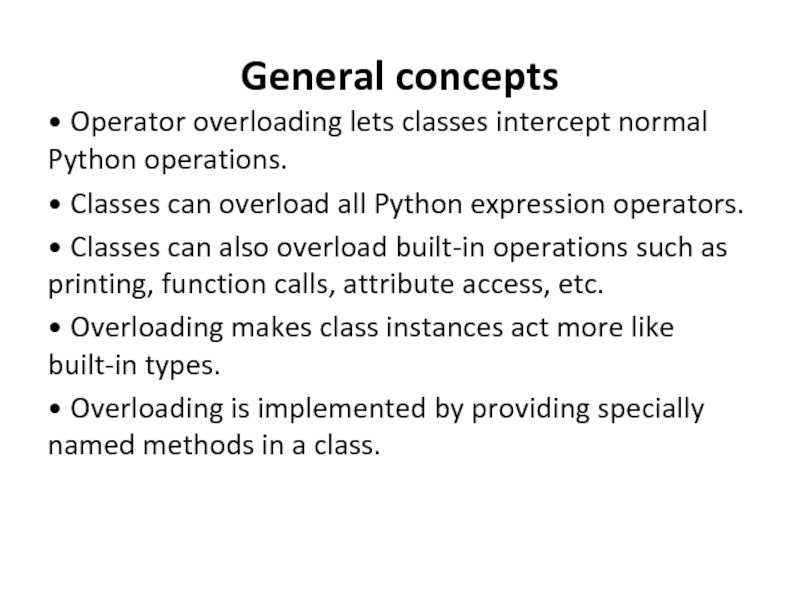

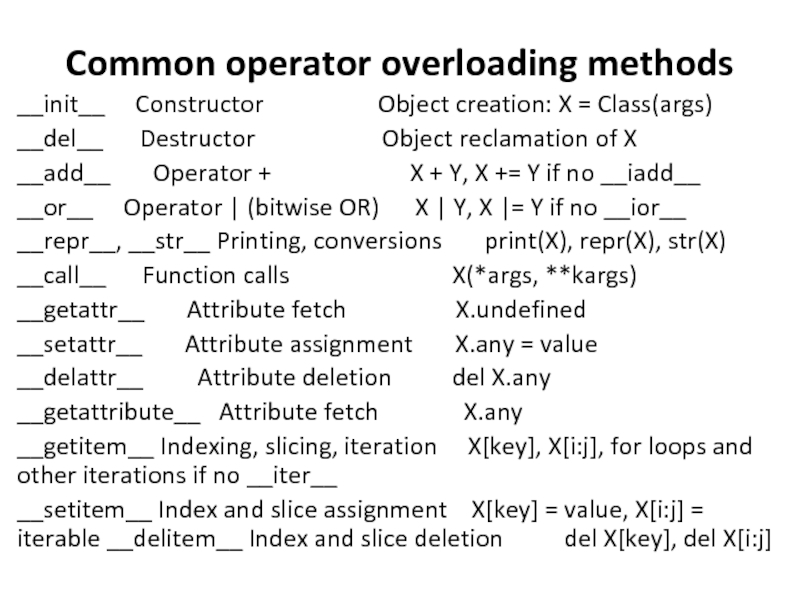

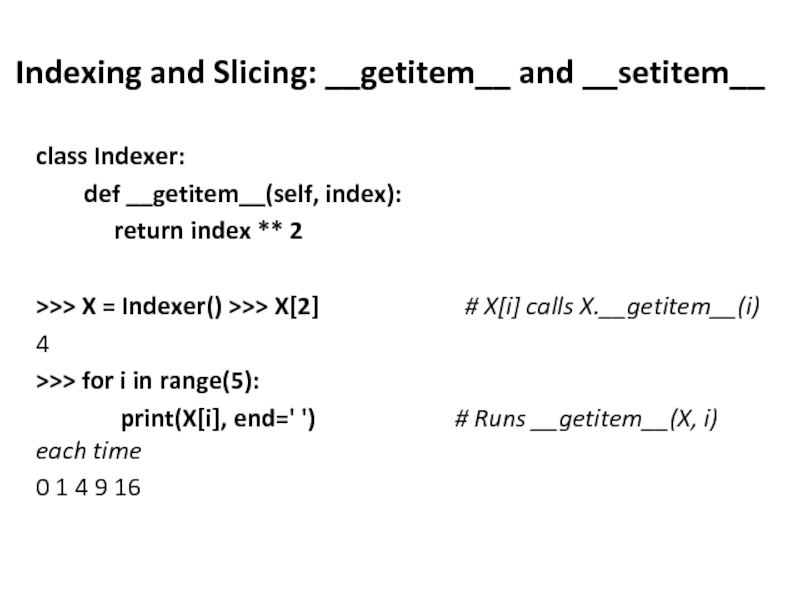
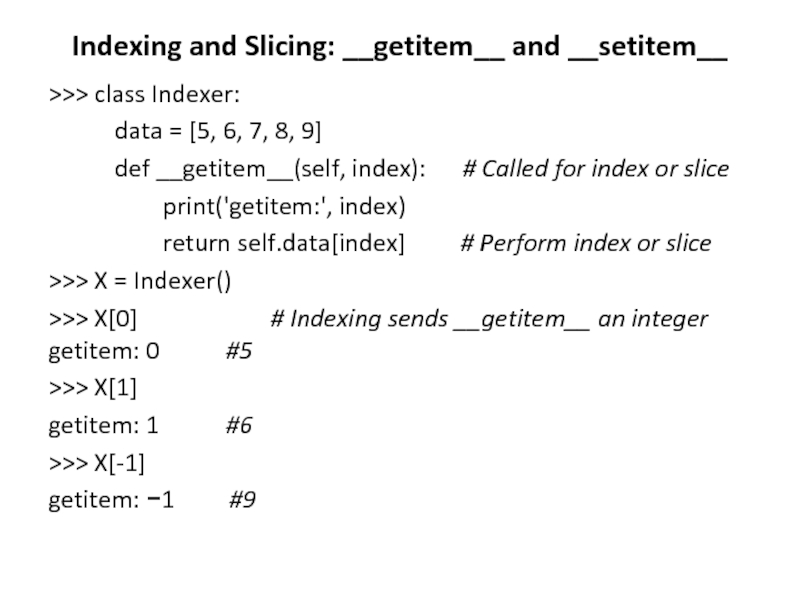
![Indexing and Slicing: __getitem__ and __setitem__ >>> X[2:4] # Slicing sends __getitem__](/img/tmb/5/448339/9663b6e313024d7f5f653bfd51363f7a-800x.jpg)
